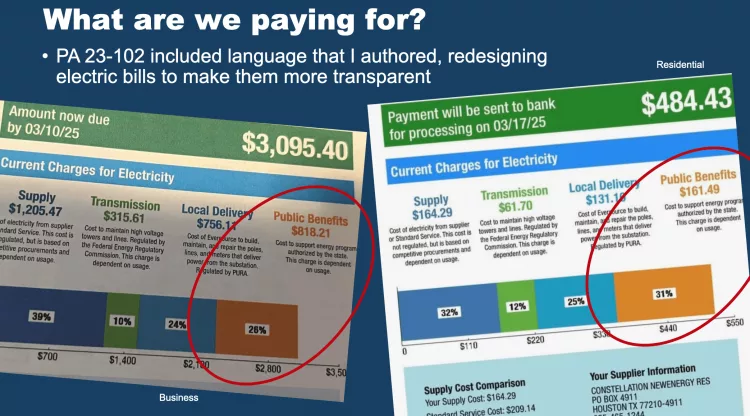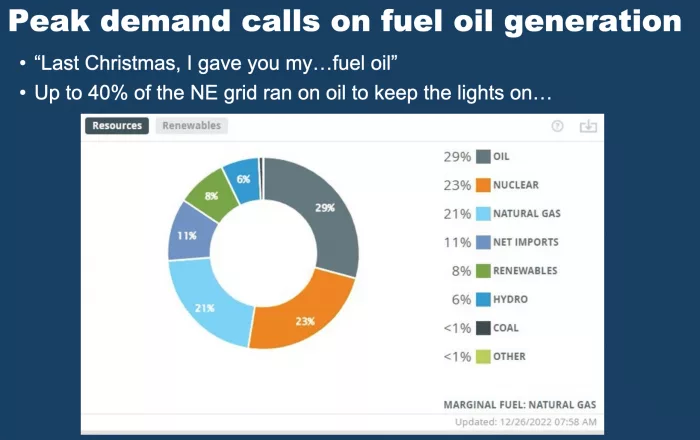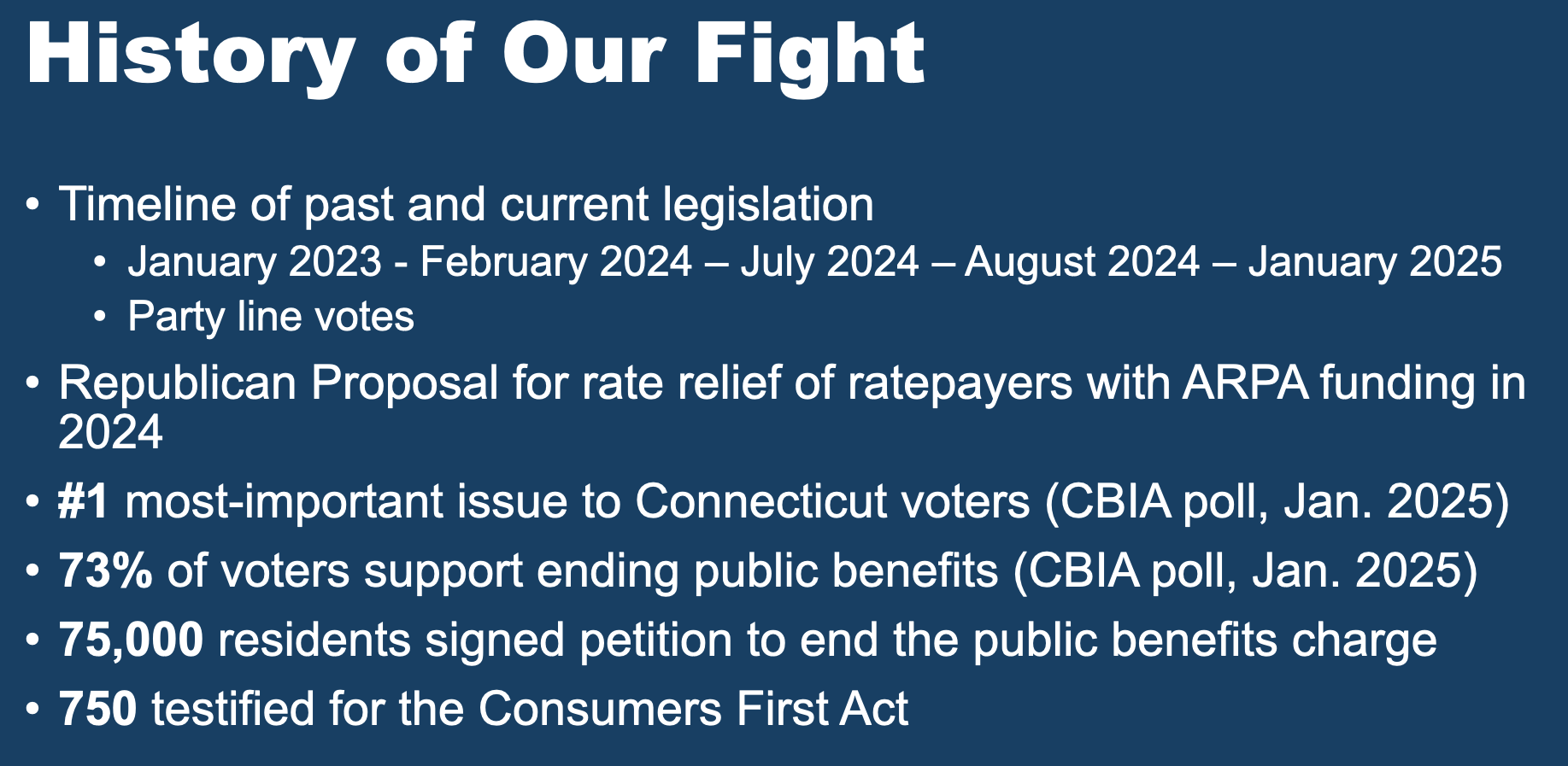
By Elizabeth Barhydt
On a spring evening in New Canaan, with the summer’s first heat creeping into forecasts, two legislators stood before a full auditorium and tried to answer a question echoing across Connecticut: Why are our electricity bills so high—and what can we do about it?
“There’s no dispute that our energy costs are too high in the state,” said State Representative Thomas O’Dea, who represents New Canaan and parts of Wilton and Ridgefield. “We’ve heard our constituents loud and clear and we’re working on it.”
State Senator Ryan Fazio, who represents Greenwich and parts of Stamford and New Canaan, added: “Electric bills are too damn high. The state bears responsibility for that, and we need to act.”
The event was part of a larger “affordability tour” launched by the two lawmakers, but the conversation wasn’t just political—it was personal. One after another, residents asked questions that revealed a growing tension between public policy, energy efficiency, and affordability.
Together, the two legislators delivered a presentation that outlined what they see as one of the state’s biggest affordability failures: an electric bill system that, in their view, charges residents for more than they use and shields those charges from scrutiny.
Their remarks came just days after Eversource, the state’s largest electric utility, issued its seasonal call to action—urging customers to reduce usage now to avoid summer spikes. Taken together, the forum and the utility advisory paint a portrait of a state bracing for higher demand, growing political friction, and calls for reform from both sides of the aisle.
Fazio and O’Dea began the forum by walking through the anatomy of a Connecticut electric bill, now mandated by law to include itemized charges for supply, transmission, delivery, and public benefits. That last line item, they argued, deserves more attention—and more outrage.
“There are 57 different government programs that are paid for through our electric bill,” Fazio explained. “They equate to over $800 million per year. For the average resident in Connecticut, that’s about $677 annually.”
O’Dea reminded the audience where the blame lies. “Who do you blame? Legislators,” he said. “We’re the ones who enacted the laws that put a lot of these things on your bill.”
A slide projected behind them showed two sample bills — one residential, one commercial. Both revealed public benefits charges accounting for more than 30% of total costs. These programs include renewable energy subsidies, low-income discounts, bill forgiveness programs, and state-mandated energy efficiency initiatives.
“They’ve more than doubled since 2018,” he added. “They’re not going away. They don’t expire. And most people had no idea they were even paying for them.”
The Consumers First Act: A Six-Point Plan
The legislators pointed to a policy solution: The Consumers First Act, a bill they introduced that would do the following:
1. Eliminate the public benefits charge from electric bills and fund programs through the general fund.
2. Cap energy contracts at 150% of wholesale electricity rates.
3. Include nuclear and hydro power in Class I renewable definitions.
4. Separate PURA from the Department of Energy and Environmental Protection to improve regulatory independence.
5. End subsidies that encourage higher demand, such as electric vehicle charger rebates.
6. Expand natural gas infrastructure to improve affordability and reliability.
“We’re not saying end every program,” Fazio noted. “But they need to be vetted, debated, and approved regularly—just like public schools, roads, and everything else.”
Conservation Measures from Eversource
While lawmakers seek longterm reform, Eversource is encouraging customers to make short-term changes.
The Summer Surge
A week before the forum, Eversource issued a public advisory reminding residents that electricity usage—and bills—rise significantly in the warmer months.
“During the summer, customers typically see their electric usage increase considerably as their air conditioners fight against the scorching temperatures,” said Steve Sullivan, Eversource’s President of Connecticut Electric Operations. “Even if the supply rate drops, overall bills tend to rise because usage increases.”
Eversource estimates that electricity usage jumps 35% from spring to summer, with last year’s record-setting heat causing a 45% spike from June to July.
Sullivan urged customers to take action now. “Installing insulation, weatherstripping doors, using ceiling fans, operating appliances during cooler hours—these changes can really help,” he said.
Home Energy Solutions
One of Eversource’s most utilized offerings is the Energize ConnecticutSM Home Energy SolutionsSM program.
For a $75 copay (or no cost for income-eligible residents), customers can receive a home visit from a certified technician. The technician inspects the home’s energy performance and performs on-the-spot improvements like sealing air leaks and installing energy-efficient lighting.
According to Ricardo Jordan, Eversource’s Energy Efficiency Manager, the average participant saves up to $180 per year on their electric bill.
“We encourage everyone to sign up,” Jordan said. “It’s one of the most effective tools we have to help people take control of their energy costs.”
A Balanced Approach:
Efficiency and Reform State Representative Tina Courpas who represents Greenwich and parts of Stamford, responded to Eversource’s public messaging.
“I support efforts to cut down on energy waste and for all of us to be more energy efficient in our homes,” Courpas said. “But let’s not insult the ratepayer by attributing last summer’s spike in electric bills to increased usage. Almost 30% of ratepayer bills are public benefits charges—a tax levied without their consent.”
“We have been pounding the table for action on this since last July, and every solution has been rejected by the majority. The elephant is still in the room. It is the public benefits charges and Connecticut’s need for a more comprehensive energy plan. It is not people running their AC too much in the summer heat.”

Local Leaders Weigh In
Greenwich First Selectman Fred Camillo praised the utility’s outreach. “With an uncertain economic environment and high peak times of energy usage ahead, it makes sense to prepare now,” Camillo said. “Their energy evaluations are something every household should consider.”
Fazio agreed. “I would also encourage residents to avail themselves of any affordable options to lower usage and costs,” he said. “Especially in the summer and winter months.”
Senator Fazio also encouraged people to get involved with lowering their electric bill in other ways.
At the close of the New Canaan forum, Senator Fazio urged residents to speak up. “People are speaking up, and it is making a difference,” he said. “We’re changing hearts and minds of people who make decisions in Hartford—and we need your voices to keep pushing.” A slide projected on the screen read simply: “What can you do? SPEAK OUT.”
Fazio encouraged attendees to contact state leaders directly, including:
Governor Ned Lamont at www.governor.ct.gov, or by phone at 860-566-4840
Senate Democrats, website: www.senatedems.ct.gov, phone: 860-240-8600, email: Looney@senatedems.ct.gov
House Democrats, website: www.housedems.ct.gov, phone: 860-240-8500, email: Matt.Ritter@cga.ct.gov
Constituents can also share testimony with legislative committees, attend town halls, or reach out through the Connecticut General Assembly website at www.cga.ct.gov to learn more about upcoming hearings and bills.
A Regulatory Decision from Hartford
On April 23, State Representative Hector Arzeno announced a decision from PURA that could bring modest relief starting May 1.
“Today the PURA Commissioners voted on an interim decision surrounding the Eversource Rate Adjustment Mechanism,” Arzeno said. “As a result, customers—including myself—can expect to see an average monthly bill drop of about $13.”
Arzeno explained the distinction between components PURA can adjust—like the Federally Mandated Congestion Charge—and those it cannot.
“These rates are updated twice a year in January and July,” he said. “PURA doesn’t set or control wholesale electricity prices. Those come through competitive bidding. But PURA ensures that companies are charging only what that electricity actually costs—no more, no less.”
Arzeno said he would be monitoring the upcoming July rate announcement, expected in mid-to-late May. “In the summer, demand for natural gas drops, so we tend to see lower generation rates,” he said. “I’ll be watching that closely.”
The Grid Is Stressed
Back at the forum, concerns extended beyond costs to grid reliability.
“On the coldest and hottest days, we still rely on oil,” Fazio said. “There was a Christmas two years ago when 40% of New England’s electricity was coming from oil-fired plants.”
Fazio explained that as the state transitions to more distributed energy—like solar panels and electric vehicles—the demands on infrastructure are multiplying.
“Eversource expects $1.5 to $2.4 billion in substation upgrades just to handle EV growth,” O’Dea said. “That breaks down to $1,500 per household.”
The costs of building a grid that can support that future, they warned, will be passed on to ratepayers unless carefully managed.
What Residents Are Saying
During the forum’s Q&A, residents asked pointed questions.
Ryan Bollinger, a New Canaan High School student, asked whether reliance on natural gas conflicted with the state’s 2040 net-zero goal.
“It’s a good question,” Fazio replied. “We need to reduce emissions while keeping energy affordable. That means nuclear, natural gas, and technology innovation.”
Christina from New Canaan asked why rooftop solar is so expensive. “I don’t understand why we all can’t just install solar and use batteries,” she said.
“Geography and infrastructure costs,” Fazio answered. “The sun doesn’t shine as much here, and the costs are higher per kilowatt for smaller systems.”
John Kuhn from Fairfield pressed on community power aggregation. Fazio said he supports allowing towns to buy energy in bulk, though he’s “not convinced it will radically cut costs.”
David Wilson of Stamford was more blunt: “It is a tax,” he said of public benefits charges. “A hidden tax. It’s going to destroy our state.”
A Public Mandate?
A January 2025 poll from the Connecticut Business & Industry Association (CBIA) showed that electricity costs are now the top issue for Connecticut voters. Of those polled, 73% support eliminating public benefits charges.
Fazio said more than 75,000 residents have signed a petition back ing the legislation, and 750 testified in support during hearings.
“A long-time legislator told me he’d never seen that much support for a single bill,” Fazio noted. Still, despite bipartisan conversation, the bill remains in committee. “It’s party-line so far,” O’Dea said. “But the momentum is building.”
Summer Awaits
As Connecticut heads into the warmest months of the year, residents are being asked to do more with less—reduce usage, monitor rates, and brace for costs that are influenced not just by how much energy they consume, but by what policies govern the grid.
“We need structural reform,” Fazio said. “But in the meantime, we also need smart habits.”







